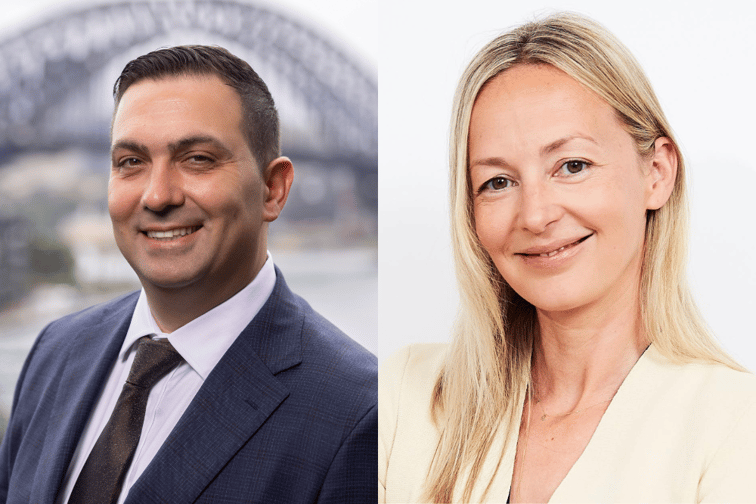

By
Higher net worth business owners and commercial property buyers are moving onto the front foot rather than being reactive this year, according to commercial finance broker George Karam, despite small business borrower default risk continuing to rise due to higher inflation and interest rates.
Karam (pictured above left), the director of Sydney brokerage BF Money, said last year was a “challenging year” for clients, with the brokerage discussing with new finance applicants and existing clients about what was a safe level of debt for them to maintain amid the uncertainty of future interest rate levels.
“We are still seeing that to some extent, but that type of work is no longer the biggest burden in our business – now, it is around helping our clients restructure their balance sheets, either so they can weather a new storm or prepare for opportunities that may arise in the coming period,” Karam said.
“The nature of the work is changing from reactionary last year to being proactive this year.”
Rather than handling business finance deals, BF Money’s clients are typically higher net worth business owners, who use the profits from their successful enterprises to invest in and grow commercial property portfolios, and handle their residential loans.
“Most of the clients we deal with own a property portfolio, and with rising interest rates that is obviously posing a challenge,” Karam said. “We have needed to have conversations around their pain points, particularly around a reduction of debt now that the cost of debt is a lot higher.”
“I think overall, people have come to terms with rates being higher than they were and that they will be higher for longer. There now seems to be a general acceptance of where we are now, or rates being just a little higher. They have come to terms with a new normal.
“This means that while we are still trying to help out some people that are taking a bit longer to pivot, the bulk of the work that we are doing now is preparing those people who are entering a phase in the cycle where they will be able to take up opportunities.”
CreditorWatch's February Business Risk Index found that projected business credit default rates for the next 12 months for most regions are considerably higher than their default rates over the past 12 months, as high inflation and interest rates further affect smaller businesses.
The index found B2B trade receivables were down 10% year-on-year as multiple challenges confront businesses, and trade payment defaults were up 30% year-on-year, reflecting a squeeze on business cash flow. It named the food and beverage as the industry as having the highest risk of default.
CreditorWatch found credit enquiries were up 102% year-on-year, and external administrations jumped 46% from January to February to near their 24-month average, and that court actions were back to pre-COVID levels, seeing their highest point since March 2020.
CreditorWatch CEO Patrick Coghlan said the results showed that businesses were under increasing stress. “From inflation to interest rates, supply chain problems, labour shortages and falling consumer demand, Australian businesses are doing it tougher now than they have since the GFC back in 2009,” he said.
Anneke Thompson, CreditorWatch chief economist (pictured above right), said it was the start of a “very difficult stage”.
“The economy is in the early stages of its downturn,” she said. “Prices are still rising, although we appear to have the worst of the price rises behind us, interest rates are likely to need to increase further, and consumer demand is slowing, and will continue to slow.
“The immediate impact is being felt by smaller businesses that are reliant on discretionary spending, before the impact flows through to the rest of the economy, including those businesses not directly exposed to consumers.”
Among BF Money’s commercial property clients, George Karam said that generally speaking, it was those able to reset their prices regularly who could better withstand rising inflation.
For example, he said the owner and operator of a hotel who could reset their prices every day had a natural hedge against inflation, while a construction company that may be locked into revenue from before they start a project would have a “much harder time” in current conditions.
“Really the determining factor is a result of cashflow management, not necessarily profits or the level of debt,” said Karam. “It’s the ability to stay liquid. We are spending more time maybe on that than we did previously, helping to analyse the cashflow of a business as opposed to the profits.”
Karam said clients restructuring their debt now that the cost of debt was higher were seeing flow-on effects for their cashflow, as the cash directed to pay debt could no longer be used in their business. He said it was a “balancing act” as loans were being reviewed and renewed by lenders.
However he said more lenders were willing to “come to the party” this year than last year, when they were not sure where rates were going to land. Lenders had partially reduced or relaxed requirements about how they analysed the debt or the amount of debt they needed to have repaid.
“Where some of the loan contracts were needing clients to maintain an ICR [Interest Cover Ratio] of two times, they are now doing assessments of 1.5 or lower to try and assist and accommodate clients in an environment where rates have gone up so much so fast.
“There is no doubt lenders are trying their best to accommodate these situations, but they are not turning a blind eye either. They may not require that clients reduce their debt by a huge amount, but they are still requiring them to provide them with something,” he said.
How are your commercial property or small business clients faring as interest rates rise? Share your thoughts in the comments section below.
